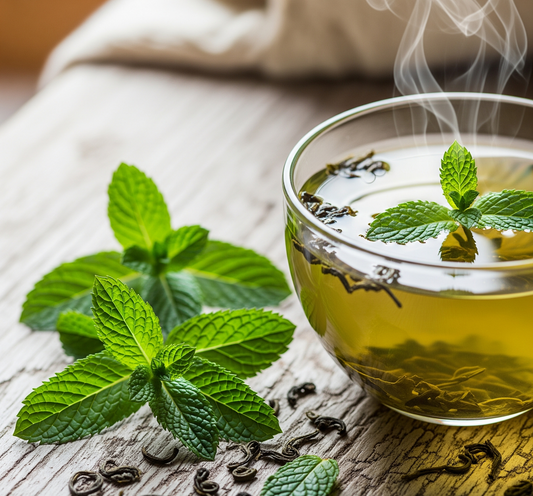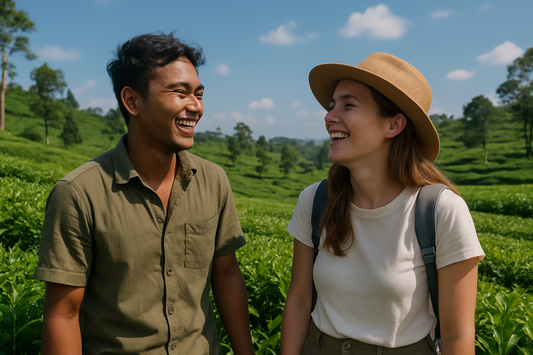White and green teas, both from the Camellia sinensis plant, differ primarily in processing. White tea, the least processed, uses young leaves, giving it a subtle, sweet flavor with floral notes and a light color. Green tea, made from slightly more mature leaves and lightly oxidized, has a fresh, grassy taste with mild bitterness. Despite its delicate nature, white tea contains a decent amount of caffeine but usually less than green tea, making it a gentler option for a caffeine boost. The key differences in brewing and taste make the choice between green tea vs. white tea a matter of personal preference.
White tea and green tea both come from the same plant, Camellia sinensis, so they're like siblings with very different personalities. Their distinct processing methods result in unique flavors and potential health perks. Understanding these differences can help you choose the perfect cup for your taste buds and lifestyle.
White Tea: The Gentle Soul of Tea

Think of white tea as that brew that’s very into meditation and the least problematic. After all, it is the least processed of all tea types, made from the youngest and most delicate tea leaves and buds. This gentle processing allows it to keep its subtle, sweet flavor with floral hints. White tea is known for its light color and delicate taste, making it a hit among those who prefer a milder tea experience.
White tea gets its name from the soft white hair found in the young tea leaves. The minimal human interference in its making ensures that the silvery appearance of the leaves is preserved and celebrated.
Check our our range of premium loose-leaf organic loose leaf white teas from Nepal Tea Collective.
Green Tea: The Energetic Yogi

Green tea, on the other hand, is like the energetic yoga enthusiast of the tea universe. It's made from slightly more mature leaves than white tea and goes through longer oxidation during processing compared to white tea leaves. This gives green tea its signature grassy, vegetal flavor with a touch of astringency. Green tea is popular for its fresh taste and potential health benefits, thanks to its high concentration of antioxidants.
Green tea gets its name from its processing method. Compared to white tea, tea pluckers pluck more mature leaves. They look greener and the minimal oxidation preserves the vividity of the leaves even after the processing. A fun little fact is that if the same batch of leaves are allowed to fully oxidize, then you’d get a black tea or oolong tea depending on the duration and the temperature.
Check our our range of premium green teas from Nepal Tea Collective.
Processing Methods: The Tea Makeover
So now you know that the main difference between white and green tea lies in when the teas were picked and how they're processed. In a way, the processing for both green and white teas is much simpler. White tea undergoes minimal processing, including withering and air-drying, to preserve its delicate flavors. It's like we’re letting nature do its thing. If you visit facilities like Kanchenjunga Tea Estate and Research Center during the early spring, then you’ll see leaves getting withered for as little as 20-30 minutes and are immediately set to dry. It is lightning-fast, compared to other slow-processed teas.
Green tea, however, gets a quick heat treatment shortly after harvesting. This heat treatment immediately stops the natural oxidation process. It is allowed to oxidize but the duration is nowhere as long as black and oolong tea. This results in its distinctive taste and color.
Appearance and Flavor Differences: Judge a Tea by Its Cover?
In terms of looks, white tea leaves are typically covered in fine, silvery-white hairs, giving them a fuzzy texture - like a tea leaf in a cozy sweater. Green tea leaves, on the other hand, have a more vibrant green color. Flavor-wise, white tea offers a subtle and sweet taste, while green tea has a fresh, grassy flavor with a slightly bitter edge. It's like comparing a whisper to a gentle breeze.
Caffeine Levels in White Tea: The Surprising Kick
Despite its delicate nature, white tea surprisingly contains a decent amount of caffeine. Young buds and leaves have caffeine as a natural insecticide to survive the harsh winter so the caffeine is there, it’s just handled with so much love and care that it never really comes out.
However, it is important to note that each cup of white tea generally contains a lower amount of caffeine than green tea because of the recommended quantity of tea leaves and the water temperature. According to healthline, One cup (250 mL) of white tea contains roughly 6–55 mg of caffeine. You will ruin a perfectly produced white tea if you try to brew a cup full of boiling water.

The intended flavor of white tea is supposed to be delicate and floral and when you use a lot of tea and steep it in piping hot water, you might end up with a cup full of strong astringent brew. The cup in your hand will most likely give you stronger caffeine kicks than a normally brewed black tea.
So if you brew it right, white tea makes for a good option for those looking for a milder caffeine boost without the jitters. Think of it as a gentle wake-up call rather than a loud alarm.
Caffeine Levels in Green Tea: The Steady Energizer
Green tea is known for its moderate caffeine content, providing a gentle pick-me-up without the crash associated with coffee. According to SUGIMOTOTEA, an 8 oz cup of green tea generally contains an average of round 28-45 mg of caffeine. Again, the caffeine levels can vary depending on factors like brewing time and tea quality.
Understanding White Tea: A Journey to Its Roots
Origins of White Tea: A Chinese Treasure
White tea has its roots in China's Fujian province, where it has been cultivated for centuries. The best white teas often come from specific regions within Fujian, such as the famous Fuding and Zhenghe areas. Like many of the world's renowned teas, white tea gained popularity as a prized tea and may have once been exclusively reserved for royalty.
Origin of Green Tea: A Serendipity
It is widely believed that green tea originated in China, dating back to 2737 BC. The discovery is known to be accidental. When Chinese Emperor Shennong drank water that had been boiled with a dead tea leaf, he found the flavor refreshing. This serendipitous moment gave birth to a new beverage. Initially, green tea was expensive and reserved for the upper echelons of Chinese society. It wasn't until the 14th century that green tea became accessible to the general public, both for enjoyment and medicinal use.
Flavor Profiles: A Taste Adventure
Characteristics of White Tea Flavors
White tea is known for its delicate, subtle flavors. It often has a light, sweet taste with floral or fruity notes. Some people describe it as having a silky texture and a clean, refreshing finish. If you look at the vast Nepal Tea Collective’s collection, you’ll notice that each white tea has flavor notes that are reminiscent of the most fairy-tale-like garden. You get hints of fresh flowers, sweet jasmine, stone fruit and so much more in every sip.
Characteristics of Green Tea Flavors
Now, green tea is more like the outgoing nature lover. It's got a bolder personality with vegetal and grassy notes, and a bit of a zing. Think of it as actually sitting down in a lush and thriving meadow. You will most likely get wafts of fresh earth, grass, vegetables, flowers, some citrus, and much more.
Best Practices for Brewing White Tea and Green Tea
Ideal Brewing Temperatures
Yes, white teas are generally air-dried or withered for a longer time, allowing some natural oxidation to occur, unlike green teas, which are heated right away to stop the natural oxidation process. Because of this minimal natural oxidation, Nepal Tea Collective’s white teas can handle slightly higher temperatures than green teas. We find that this brings out more flavor, though it’s also a matter of personal preference.
In general, white teas are brewed at 175-180°F, except for those super delicate ones. But here's a pro tip: both white and green teas prefer cooler vibes. We're making tea, not caffeine soup—so no boiling water, please! For the best results, Nepal Tea Collective recommends using 2 grams of white tea leaves in 8 ounces of water at 180°F, steeped for 4 minutes. For green tea, the recommended temperature is 160°F, steeping 2 grams in 8 ounces of water for 3 minutes.
Steeping Time
The steeping time is crucial for both teas. White tea should be steeped for 2-5 minutes to enhance its subtle flavors without becoming too strong. Green tea, on the other hand, should be steeped for 1-3 minutes to prevent a bitter taste.
Leaf Quantity
Using the right amount of tea leaves is essential. For both white and green tea, use approximately 2 grams of tea leaves per 8 ounces (240 ml) of water. Adjust the quantity according to your taste preferences for a perfect brew.
Water Quality
The quality of water significantly impacts the taste of your tea. Use fresh, filtered water to ensure the best flavor. Avoid using distilled or previously boiled water, as it can negatively affect the tea's taste.
Tea Preparation
Pre-warming your teapot or cup is a simple yet effective step to nurture the flavors out of the leaves and into your sip. Rinse your vessel with hot water before brewing. This helps maintain the optimal brewing temperature and enhances the overall tea experience, ensuring a more consistent and enjoyable flavor.
With these tips, enjoy the delicate, soothing flavors of white tea and the refreshing, vibrant taste of green tea! Whether you’re starting your day or winding down, a perfectly brewed cup with a minimal caffeine kick to ruin your peace, every sip will elevate your tea experience.




